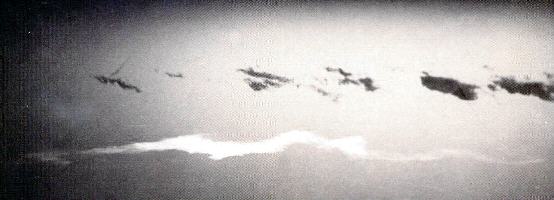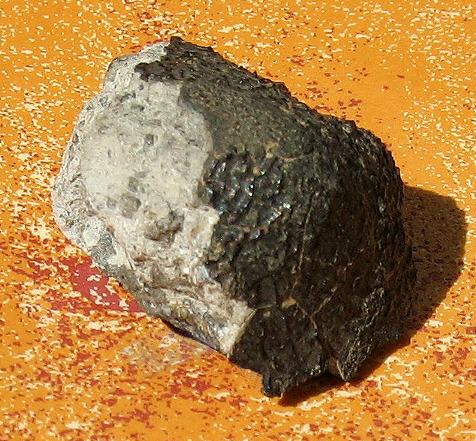Pasamonte
AchondriteAn achondrite is a type of stony meteorite whose precursor was of chondritic origin and experienced metamorphic and igneous processes. They have a planetary or differentiated asteroidal origin where the chondritic parent body reached a sufficient size that through heating due to radioactive decay of 26Al (aluminum isotope) and gravitational Click on Term to Read More, ungroupedModifying term used to describe meteorites that are mineralogically and/or chemically unique and defy classification into the group or sub-group they most closely resemble. Some examples include Ungrouped Achondrite (achondrite-ung), Ungrouped Chondrite (chondrite-ung), Ungrouped Iron (iron-ung), and Ungrouped Carbonaceous (C-ung). Click on Term to Read More
eucrite-like basaltic
(previously Eucrite-polymict)
Fell March 24, 1933
36° 13′ N., 103° 24′ W. At 5:00 on a March morning, ~100 stones totaling 3–4 kg were heard and seen to fallMeteorite seen to fall. Such meteorites are usually collected soon after falling and are not affected by terrestrial weathering (Weathering = 0). Beginning in 2014 (date needs confirmation), the NomComm adopted the use of the terms "probable fall" and "confirmed fall" to provide better insight into the meteorite's history. If Click on Term to Read More in New Mexico, after putting on a display for observers in New Mexico, Colorado, Kansas, Oklahoma, and as far away as Texas and Wyoming. The fireballA fireball is another term for a very bright meteor, generally brighter than magnitude -4, which is about the same magnitude of the planet Venus as seen in the morning or evening sky. A bolide is a special type of fireball which explodes in a bright terminal flash at its end, often with visible fragmentation. Click on Term to Read More left a thick, twisting dust trail, perhaps a mile wide and hundreds of miles long, comprising perhaps thousands of tons of material. Grabbing his Kodak Brownie camera, a rare photo of the actual fireball in flight was taken by the quick-acting Charles M. Brown as it spiralled towards Earth (see below), and other images of the remnant twisted dust cloud were captured. Information was recorded in a note by Harvey Nininger describing the scene as photographed by Charles Brown: Great meteorHow long Sonic booms Of the several 10s of tons of cosmic material entering Earth's atmosphere each day, only about one ton reaches the surface. An object's chance of survival depends on its initial mass, speed and angle of entry, and friability (tendency to break up). Micrometeoroids radiate heat so Click on Term to Read More of Mar. 24 1933. Photo by Chas. M. Brown and copyrighted by him. Nininger survey demonstrated that meteor was visible for 15 to 22 seconds. Cloud remained visible 3 hrs. or more. Diameter of luminous sphere was about 6 miles. Diameter of spiral train was about 1 mile. Meteorites from this fall were strewn along a path of 28 miles having a width of about 2 to 3 miles wide. The fall was in an E.N.E. to W.S.W. direction beginning about 25 mi. W.S.W. from Clayton New Mexico. Meteorites were preserved in America MeteoriteWork in progress. A solid natural object reaching a planet’s surface from interplanetary space. Solid portion of a meteoroid that survives its fall to Earth, or some other body. Meteorites are classified as stony meteorites, iron meteorites, and stony-iron meteorites. These groups are further divided according to their mineralogy and Click on Term to Read More Museum, U.S. 66, west of Winslow Arizona. The small stones were collected by ranchers along a distance of 28 miles near the Pasamonte Ranch, and these were subsequently identified as meteorites by Harvey Nininger, who had independently located the strewnfield after spending many months conducting eyewitness interviews.
- Main Group (primary basaltBasalt is the most common extrusive igneous rock on the terrestrial planets. For example, more than 90% of all volcanic rock on Earth is basalt. The term basalt is applied to most low viscosity dark silicate lavas, regardless of composition. Basalt is a mafic, extrusive and fine grained igneous rock Click on Term to Read More): Mg# ~ 0.38–0.41; Ti ~ 3–4 mg/g
- Stannern trend (primary partial melt): Mg# similar to main series; Ti up to 5.7 mg/g
- Nuevo Laredo trend (fractional crystallization): Mg# extends from Main Group to 0.32; Ti = 5.7 mg/g
A plot of the three subgroups shows a convergence at the center of the Main Group, implying that a genetic relationship (i.e., same parent bodyThe body from which a meteorite or meteoroid was derived prior to its ejection. Some parent bodies were destroyed early in the formation of our Solar System, while others like the asteroid 4-Vesta and Mars are still observable today. Click on Term to Read More) exists among them, and a possible derivation of the two trends from the primary melts of the Main Group. Currently, the Main Group is combined with the Nuevo Laredo Trend to form a single series, while the Stannern Trend represents Main Group magmaMolten silicate (rock) beneath the surface of a planetary body or moon. When it reaches the surface, magma is called lava. Click on Term to Read More that has been contaminated by a crustal partial melt.
It has been demonstrated that the HED parent body was relatively homogenous in its O-isotopic composition. In a study of a number of eucrites having anomalous O-isotopic ratios and/or anomalous chemical compositions, textures, or ages, evidence was presented indicating that Pasamonte must have originated on a parent body distinct from that of the other HED meteorites (Scott et al., 2008, 2009). For example, its significant displacement from the Eucrite FractionationConcentration or separation of one mineral, element, or isotope from an initially homogeneous system. Fractionation can occur as a mass-dependent or mass-independent process. Click on Term to Read More Line (EFL)—plotting ~4.7 standard deviations from the eucrite/diogenite mean Δ17O value—cannot be reasonably explained by the admixture of foreign impactor contaminates, by terrestrial weathering processes, or by an isotopically heterogeneous parent body. Pasamonte has a pyroxene Fe/Mn ratio of 29, which is at the lower range (28–40) of typical eucrites. Moreover, its chromites have compositions which are much more Al-rich and Ti-poor than in other eucrites. It is reasonable to assume that Pasamonte was derived from one of many Vesta-sized asteroids that likely existed early in Solar SystemThe Sun and set of objects orbiting around it including planets and their moons and rings, asteroids, comets, and meteoroids. history, prior to the Late Heavy BombardmentPeriod between ~4.0 to 3.8 Ga ago when the Moon and other objects in the Solar System were pounded heavily by wayward asteroids. The evidence for the Late Heavy Bombardment (LHB) includes the lunar maria basins and similar structures elsewhere, such as the Caloris Basin on Mercury and the great Click on Term to Read More period ~3.5–4.1 b.y. ago. Notably, the paired brecciated, vesiculated basalts PCA 82502 and PCA 91007 have O-isotopic compositions which are virtually identical to Pasamonte (see diagram below), and they have similar anomalously high abundances of certain siderophile elements (Ni, Ir, Os) as well; it could be inferred that they formed in a common nebular region (Scott et al., 2009).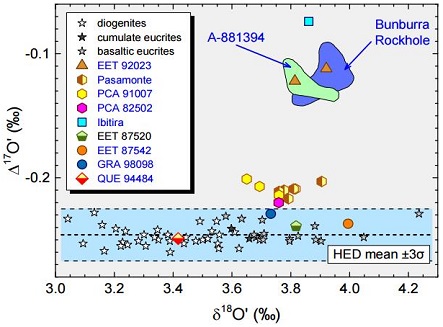
Diagram credit: Mittlefehldt et al., 47th LPSC, #1240 (2016) As presented by Sanborn and Yin (2014) [#2018], a Δ17O vs. ε54Cr diagram is one of the best available diagnostic tools for determining genetic (parent body) relationships among meteorites, constrained by the degree to which isotopic homogenization occurred on their respective parent bodies. Moreover, Sanborn et al. (2015) demonstrated that ε54Cr values are not affected by aqueous alteration. Currently, a number of anomalous eucritic meteorites are known, including Ibitira, Pasamonte, NWA 1240, PCA 82502/91007, Bunburra Rockhole, A-881394, EET 92023, and Emmaville, each of which are resolved from typical eucrites and the HED parent body both isotopically and compositionally; notably, the latter four anomalous eucritic meteorites share close similarities in their O-isotopes and might be genetically related (Barrett et al., 2017; see O-isotopic diagram). However, a high-resolution Δ17O diagram presented by Mittlefehldt et al. (2018) appears to distinguish many of these meteorites from each other, with two couples—Pasamonte with PCA 91007 and Bunburra Rockhole with EET 92023—showing overlapping values (see diagram below). Asuka 881394 is exceptional in having the oldest measured U–Pb age of any achondrite. Employing the precise 238U/235U value of 137.768, 2015), Wimpenny et al. (2019) determined the most precise and accurate Pb–Pb isochron age for A-881394 of 4.56495 (± 0.00053) b.y. By comparison, the ungrouped NWA 11119 (likely related to NWA 7325) has an Al–Mg age relative to D’Orbigny of 4.5648 (± 0.0003) b.y. (Srinivasan et al., 2018).
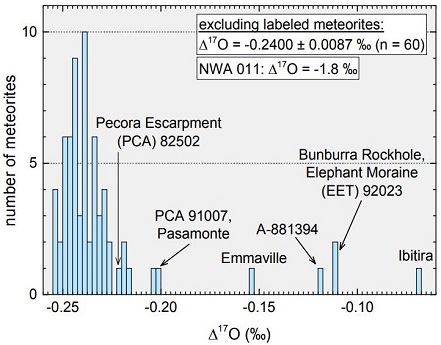
Diagram credit: Mittlefehldt et al., 49th LPSC, #2700 (2018) Another useful tool to help resolve potential genetic relationships among meteorites is the pyroxene Fe/Mn ratio. While Fe and Mn do experience nebular fractionations, they are not readily fractionated during parent body igneous processing, and therefore different Fe/Mn values are inherent in different parent objects. Mittlefehldt et al. (2017) utilized a number of eucrites and anomalous eucrite meteorites, including A-881394, EET 92023, Ibitira, and Emmaville, to compare the Fe/Mn and Fe/Mg ratios in low-Ca pyroxenes. Consistent with the O-isotopic results, these four meteorites plot in separate locations on an Fe/Mn vs. Fe/Mg coupled diagram, which suggests that they derive from separate parent bodies (see top two diagram below). Moreover, despite the fact that Pasamonte and PCA 82502/91007 are similar with respect to both Δ17O and ε54Cr values (see Sanborn et al., 2016, #2256), these two meteorites are resolved on an Fe/Mn vs. Fe/Mg coupled diagram, which suggests that they derive from separate parent bodies as well (see bottom diagram below).
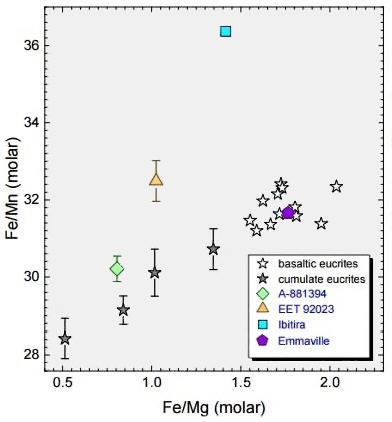
Diagram adapted from Mittlefehldt et al., 47th LPSC, #1240 (2016)
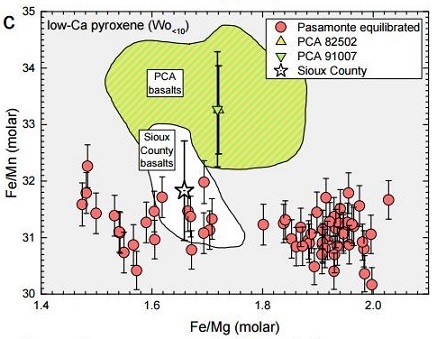
Diagram credit: Greenwood et al., 48th LPSC, #1194 (2017) It is known that ureilites, generally considered to originate from a common parent body, have a relatively wide degree of variability in Δ17O, but a relatively narrow degree of variability in ε54Cr. By comparison, Sanborn et al. (2014) inferred that the similar degrees of variability that exist among these anomalous eucritic meteorites could likewise reflect a common origin from a single Vesta-like parent body distinct from typical eucrites (see diagram below). Several exceptions to this hypothesis have since been identified including the following: NWA 1240 plots away from the common HED field; PCA 82502/91007 is resolved from the other anomalous eucrites by both O-isotopes and pyroxene Fe/Mn ratio; A-881394 has significantly different oxygenElement that makes up 20.95 vol. % of the Earth's atmosphere at ground level, 89 wt. % of seawater and 46.6 wt. % (94 vol. %) of Earth's crust. It appears to be the third most abundant element in the universe (after H and He), but has an abundance only Click on Term to Read More isotopes, Ti/Al and Fe/Mn values, and bulk composition compared to HEDs (Mittlefehldt et al. (2015); and EET 92023 exhibits significant differences in O-isotopes, Cr-isotopes (Sanborn et al., 2016, #2256), and pyroxene composition compared to HEDs and other anomalous achondrites. EET 92023 shares similar O- and Cr-isotopes to A-881394 and Bunburra Rockhole indicating that they each formed within a common isotopic reservoir. Under the hypothesis that Δ17O values serve equally well as a discriminator compared to ε54Cr values, all of these anomalous meteorites could derive from numerous unique parent bodies distinct from VestaThird largest and fourth brightest asteroid; it was discovered in 1807 by Heinrich Olbers and named for the ancient Roman goddess of the hearth. 4 Vesta has a basaltic surface composition and an average density not much less than that of Mars. Evidently lava once flowed here indicating that the (see diagram below). Furthermore, although Bunburra Rockhole and A-881394 have the same oxygen and chromium isotopeOne of two or more atoms with the same atomic number (Z), but different mass (A). For example, hydrogen has three isotopes: 1H, 2H (deuterium), and 3H (tritium). Different isotopes of a given element have different numbers of neutrons in the nucleus. Click on Term to Read More compositions, new in-depth analyses of Bunburra Rockhole conducted by Benedix et al. (2017, and references therein) have revealed that these two meteorites have very different textures and mineralInorganic substance that is (1) naturally occurring (but does not have a biologic or man-made origin) and formed by physical (not biological) forces with a (2) defined chemical composition of limited variation, has a (3) distinctive set of of physical properties including being a solid, and has a (4) homogeneous Click on Term to Read More chemistries; e.g., Bunburra Rockhole has plagioclaseAlso referred to as the plagioclase feldspar series. Plagioclase is a common rock-forming series of feldspar minerals containing a continuous solid solution of calcium and sodium: (Na1-x,Cax)(Alx+1,Si1-x)Si2O8 where x = 0 to 1. The Ca-rich end-member is called anorthite (pure anorthite has formula: CaAl2Si2O8) and the Na-rich end-member is albite Click on Term to Read More with An87–90, while A-881394 has plagioclase with An98. Based on their results, they consider it likely that these two meteorites also derive from separate parent bodies.
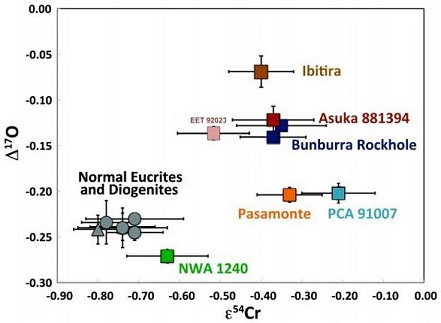
Diagram adapted from Sanborn and Yin, 45th LPSC, #2018 (2014) One more anomalous eucrite-like achondrite, classified as NWA 12338, has joined this disparate group. This unbrecciated basaltic meteorite is geochemically similar to eucrites but has some differences in its texture and mineralogy, and it has O-isotopic values that plot in a distinct space above the HED trend (see diagram below).
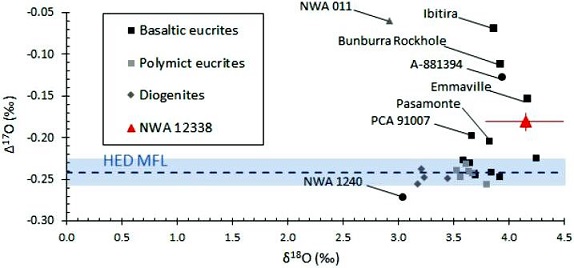
Diagram credit: Guo et al., 50th LPSC, #1583 (2019) Because there are now a number of eucrite-like meteorites that are not grouped with normal eucrites for various reasons, it was proposed that the term ‘eucrite’ be used as a description of a rock type rather than to imply an origin on the presumed HED parent body Vesta. The photo above shows a partially fusion-crusted 18.93 g specimen of Pasamonte acquired from the Robert Haag Collection.
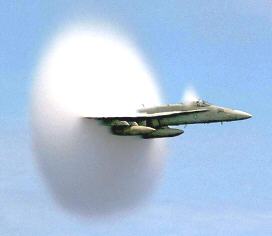
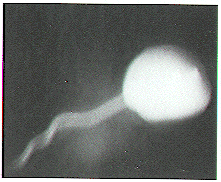
The left photo above captures the shock-generated condensation cloud at the moment when a jet breaks the sound barrier. Compare this to the Pasamonte fireball photo on the right. The corkscrew appearance of the dust train attests to the spinning motion of the incoming object over an extended period of time. The photo below shows the persistent dust cloud of the Pasamonte meteorite showing the effects of adiabaticProcess in which no heat enters or leaves a system. This is the case, for example, when an interstellar gas cloud expands or contracts. Adiabatic changes are usually accompanied by changes in temperature or volume. Click on Term to Read More processes.
